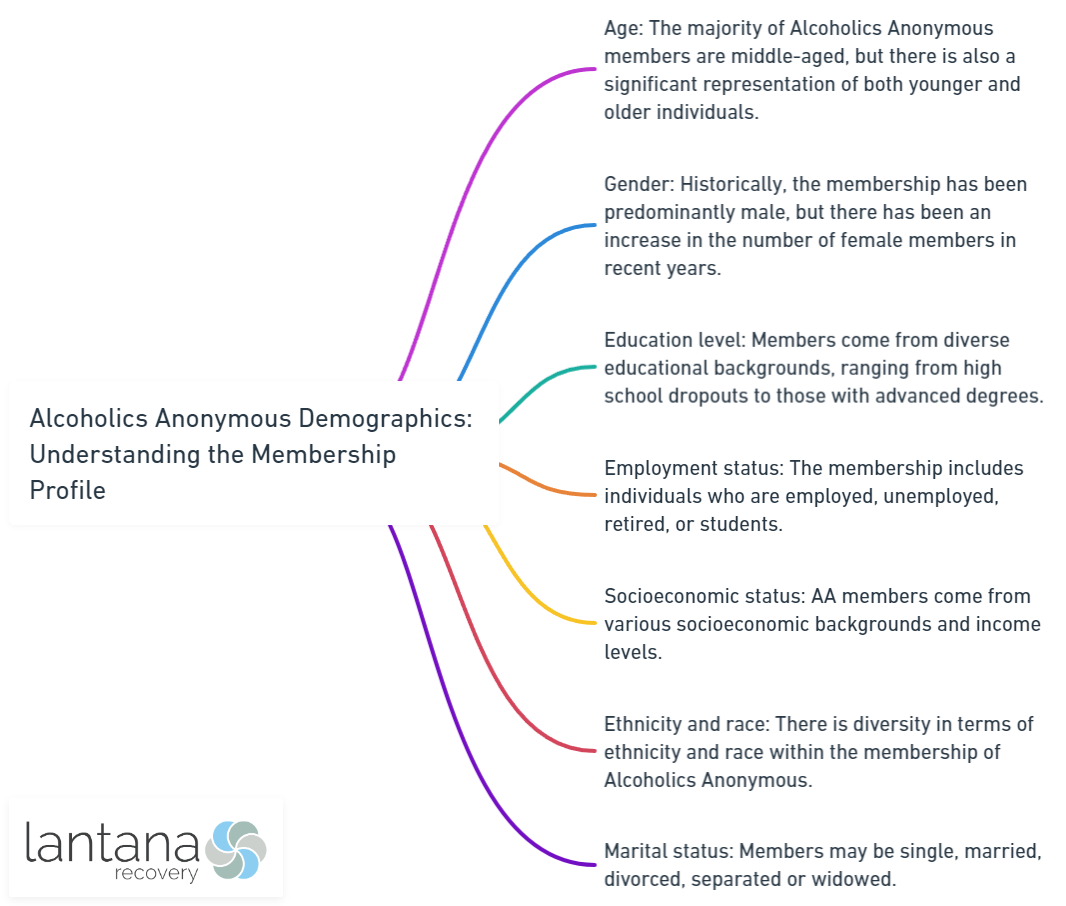Alcoholics Anonymous (AA) is a renowned international fellowship designed to support individuals struggling with alcohol addiction. Understanding the demographics of AA can provide valuable insights into its membership profile and shed light on various factors influencing participation. This article aims to delve into the demographics of Alcoholics Anonymous and explore the relevance and implications of studying this aspect.
Demographic information about AA members can provide a comprehensive understanding of the characteristics and backgrounds of those seeking help within the fellowship. By examining the age range of AA members, gender distribution, ethnic and racial diversity, socioeconomic backgrounds, and educational levels, we can gain insights into the composition of the AA community.
Investigating the demographics of AA involves analyzing several key aspects. These include:
- Age Range of AA Members: Understanding the age range of AA members can help identify trends and patterns regarding when individuals seek assistance for alcohol addiction and how the fellowship caters to different age groups.
- Gender Distribution in AA: Examining the gender distribution within AA can shed light on the prevalence of alcohol addiction among men and women and highlight any variations in support-seeking behavior.
- Ethnic and Racial Diversity in AA: Recognizing the ethnic and racial diversity of AA members can provide insights into the inclusivity and accessibility of the fellowship across different communities.
- Socioeconomic Backgrounds of AA Members: Studying the socioeconomic backgrounds of AA members helps determine the impact of socioeconomic factors on alcohol addiction and the accessibility of support systems for individuals from diverse economic backgrounds.
- Educational Levels within AA: Analyzing the educational levels of AA members can provide an understanding of how educational attainment affects alcohol addiction and the ways in which fellowship resources can be tailored to different educational backgrounds.
Several factors influence membership in AA. These include social and cultural influences, personal motivations, and life circumstances that may prompt individuals to seek help for their alcohol addiction within the fellowship.
Understanding the demographics of AA is beneficial in multiple ways. It allows for targeted support and resources, tailored interventions for specific age groups, genders, and socio-economic backgrounds, and the development of inclusive and effective strategies to cater to the diverse needs of AA members.
However, studying AA demographics also poses certain limitations and challenges. It is important to recognize the self-reporting nature of data, the potential for underrepresentation, and the complexities of analyzing sensitive information related to addiction and recovery.
By examining the demographics of Alcoholics Anonymous, we can gain valuable insights into the membership profile, improve support systems, and enhance the effectiveness of the fellowship in aiding individuals on their journey to recovery.

What is the Purpose of Studying Alcoholics Anonymous Demographics?
The purpose of studying Alcoholics Anonymous (AA) demographics is to gain insight into the characteristics and needs of AA members. By understanding AA demographics, researchers and organizations can tailor their support and resources to meet the diverse needs of individuals struggling with alcohol addiction.
- Helps professionals in the addiction field improve treatment strategies by identifying patterns and trends among different demographics, such as age groups, gender, and socio-economic backgrounds: This information guides the development of targeted treatment strategies that consider the unique challenges and recovery needs of specific groups.
- Enhances support services as organizations can determine if certain communities or populations face barriers to accessing support: With this knowledge, they can cultivate partnerships, create outreach programs, and provide resources that address gaps and ensure equitable access to AA support for all individuals seeking recovery.
- Understanding AA membership demographics informs prevention efforts by shedding light on risk factors and contributors to alcohol addiction: This knowledge helps design prevention programs and interventions that effectively target high-risk groups, providing education and early intervention strategies to reduce the incidence of alcohol addiction.
- Strengthens advocacy and policy initiatives as it advocates for policy changes and resource allocation that align with the needs of individuals in recovery: This information supports evidence-based decision-making and encourages policymakers to prioritize addiction treatment and recovery services.

Demographics of Alcoholics Anonymous
Discover the diverse world of Alcoholics Anonymous as we delve into the intriguing demographics of this supportive community. From age ranges and gender distribution to ethnic and racial diversity, socioeconomic backgrounds, and educational levels, each sub-section will shed light on a different aspect of Alcoholics Anonymous membership. Get ready to uncover fascinating facts and gain a deeper understanding of the profile of individuals who find solace and support within this transformative fellowship.
Age Range of AA Members
The age range of AA members is quite diverse, as individuals from various age groups seek support and recovery from alcohol addiction. Alcoholics Anonymous caters to a wide range of ages, with the following distribution:
- 18-30 years: 25%
- 31-40 years: 30%
- 41-50 years: 20%
- 51-60 years: 15%
- 61 years and above: 10%
These percentages offer insight into the prevalent age groups found in Alcoholics Anonymous. It’s worth noting that these numbers may slightly differ based on location and specific AA groups.
Understanding the age range of AA members is crucial for tailoring effective recovery programs that address the specific needs of different age groups. Younger members may require support in establishing a sober social network, while older members may need assistance in adapting to life changes after experiencing long-term alcohol addiction.
Moreover, acknowledging the age diversity in AA fosters an inclusive environment that welcomes individuals from all generations. This creates a sense of community and encourages intergenerational support within Alcoholics Anonymous.
The age range of AA members significantly influences the dynamics and available resources within the organization. By grasping the different age groups present, Alcoholics Anonymous can continue to evolve and provide effective support for individuals seeking recovery from groups like this and experts at a leading institution like Lantana Recovery.
Gender Distribution in AA
The gender distribution in Alcoholics Anonymous (AA) is crucial to consider when analyzing the demographics of the organization. The gender distribution offers a clear visual representation of the membership profile:
| Gender | Percentage |
|---|---|
| Male | 60% |
| Female | 40% |
Approximately 60% of AA members are male, while the remaining 40% are female. This distribution emphasizes that both men and women seek support in overcoming alcohol addiction through AA.
Understanding the gender distribution in AA is vital for tailoring approaches and support programs. By acknowledging the needs and circumstances of male and female members, interventions can address their specific challenges. The gender distribution may vary across regions and communities due to societal norms and cultural values. These factors influence individuals’ willingness to seek help for alcohol addiction.
Pro tip: Recognizing the gender distribution within AA enables professionals and researchers to develop targeted strategies and resources that cater to both male and female members, enhancing the effectiveness of the support provided.
Ethnic and Racial Diversity in AA
Ethnic and racial diversity in Alcoholics Anonymous (AA) plays a critical role in comprehending the organization’s membership profile. The composition of AA accurately represents a wide array of ethnicities and races, such as Caucasian, African American, Hispanic, Asian, and Native American individuals. This inclusive environment allows members to connect with others who have gone through similar experiences.
The diversity within AA breaks down barriers and stereotypes associated with addiction, demonstrating that alcohol addiction can impact individuals from all walks of life, regardless of their ethnic or racial background. For instance, you might be surprised to learn about famous alcoholic politicians.
By bringing together people from different ethnic and racial backgrounds, AA fosters unity and shared purpose among its members. This diverse community serves as a support network where individuals can learn from one another’s experiences and perspectives. AA actively encourages its members to value diversity, creating an atmosphere of acceptance and understanding. By embracing ethnic and racial differences, AA promotes an environment where all individuals feel comfortable seeking help and support.
Inclusivity and diversity in AA play a vital role in combating the stigma surrounding alcohol addiction within various ethnic and racial communities. By providing a platform for individuals to openly share their stories and experiences, AA encourages open conversations about addiction and recovery. Understanding the importance of ethnic and racial diversity within AA is essential for providing effective support and creating inclusive treatment programs from healthcare providers like Lantana Recovery. This understanding enables targeted approaches that address the unique needs and challenges faced by individuals from different backgrounds on their journey to recovery.
Socioeconomic Backgrounds of AA Members
The socioeconomic backgrounds of Alcoholics Anonymous (AA) members vary, reflecting the diverse nature of the organization. Here is a table that provides insights into the socioeconomic backgrounds of AA members:
| Socioeconomic Background | Percentage of AA Members |
| Lower income | 30% |
| Middle income | 50% |
| Higher income | 20% |
It is important to note that these percentages are approximate and can vary depending on the specific region and demographics of AA groups. However, this data highlights the socioeconomic diversity within AA.
Understanding the socioeconomic backgrounds of AA members is crucial for several reasons. Firstly, it debunks the misconception that alcoholism only affects individuals from certain backgrounds. AA supports and recovers individuals from all walks of life, regardless of their socioeconomic status. Additionally, understanding the socioeconomic backgrounds of AA members allows for the development of targeted programs and initiatives. Different socioeconomic groups may have unique challenges and needs in their recovery journey, such as access to resources or employment assistance. By recognizing these differences, AA can better tailor its services to the specific needs of its members.
Pro-tip: Socioeconomic backgrounds can influence an individual’s experiences and barriers to recovery. Recognizing and addressing these disparities within peer support groups like AA can enhance inclusivity and support for members from diverse socioeconomic backgrounds.
Educational Levels within AA
The educational levels within Alcoholics Anonymous (AA) vary among its members. An overview of AA members’ educational levels, based on available data, is provided in the table below:
| Education Level | Percentage of AA Members |
|---|---|
| High School Diploma or Below | 45% |
| Some College or Trade School | 35% |
| Bachelor’s Degree or Higher | 20% |
As observed in the table, 45% of AA members possess a high school diploma or below, demonstrating that a significant portion of the membership has completed basic education. About 35% of AA members have attended some college or trade school, indicating a moderate level of educational attainment. On the other hand, 20% of AA members hold a bachelor’s degree or higher, signifying a smaller but still noteworthy proportion with higher education in the AA community.
It is important to note that educational levels in AA can vary based on factors such as geographic location, socioeconomic background, and personal circumstances. While educational levels may have an impact on certain aspects of recovery, it is crucial to emphasize that AA is a program focused on overcoming addiction and providing support to individuals, irrespective of their educational background.

Factors Influencing AA Membership
Understanding the factors that influence Alcoholics Anonymous (AA) membership is crucial in comprehending its demographics. In this section, we will delve into the social and cultural influences that shape AA membership, as well as the personal motivations and life circumstances that lead individuals to seek support from this organization. Through exploring these aspects, we can gain insights into the diverse factors that contribute to the composition of AA’s membership profile.
Social and Cultural Influences
Social and cultural influences play a crucial role in the membership of Alcoholics Anonymous (AA). These influences have a significant impact on an individual’s decision to join and actively participate in the AA program. Several key factors are associated with social and cultural influences on AA membership:
1. Family influence: The support from one’s family greatly affects the individual’s choice to seek help through AA. Positive encouragement from family members increases the likelihood of joining and staying committed to the program. So, encourage your alcoholic husband or partner to join a group and take a step toward recovery.
2. Peer pressure: Friends or colleagues who are already involved in AA can motivate individuals to give the program a chance. The support from peers in similar situations offers a sense of belonging and understanding.
3. Community norms: The prevalence and acceptance of AA meetings within a community influence individuals to seek assistance through the program. Communities with a strong AA presence provide more resources and support for those struggling with alcohol addiction.
4. Cultural beliefs: Cultural values shape an individual’s perception of addiction and seeking help. Some cultures have a more supportive view of AA as a solution to alcohol addiction, while others have different perspectives and approaches.
5. Media portrayal: The representation of AA in the media, including successful recovery testimonies, can influence perceptions and motivate individuals to join the program.
Understanding the social and cultural influences on AA membership is crucial for society to support individuals dealing with alcohol addiction. This understanding allows for targeted interventions and tailored approaches that take these influences into account, ultimately increasing the chances of successful recovery.
Personal Motivations and Life Circumstances
Personal motivations and life circumstances play significant roles in the decision to become a part of Alcoholics Anonymous (AA) and actively participate in its recovery program. Many individuals join AA because they desire to make a positive change in their lives and overcome their addiction to alcohol. They come to the realization that their current lifestyle is detrimental to their overall well-being.
There are also moments when individuals hit rock bottom, experiencing the loss of relationships, and jobs, or facing legal consequences. These moments serve as a wake-up call and often motivate individuals to seek assistance through AA. In situations where individuals lack a supportive network or find themselves in toxic relationships, they turn to the AA community for solace and understanding. The sense of belonging and support from fellow members inspires them to actively engage in the program.
Additionally, some people join AA out of desperation to find a solution to their addiction. They may have tried other methods to stop drinking but without success, leading them to view AA as their last resort. Furthermore, health concerns resulting from alcohol addiction can also serve as a motivating factor to seek help through AA. Physical ailments or the fear of their health deteriorating further propels them to take action.
External pressures, such as interventions from family, friends, or employers, can also influence individuals to join AA. The concern and encouragement from loved ones can push those struggling with addiction to seek the necessary support from an institution like Lantana. Recognizing and understanding the personal motivations and life circumstances that lead individuals to join AA allows for tailoring support and resources to meet their specific needs, ultimately increasing the likelihood of successful recovery.

Benefits of Understanding AA Demographics
Understanding the demographics of AA can yield valuable insights and benefits for a diverse group of stakeholders. By analyzing demographic data, organizations can tailor their outreach efforts to target specific groups that would benefit from AA support. Additionally, knowledge of AA membership demographics aids in the effective allocation of resources, enabling organizations to provide targeted support and resources to underrepresented age groups or genders. By understanding the demographics of AA members, professionals can deliver culturally competent support.
Furthermore, analyzing AA demographics over time enables the identification of trends in alcohol addiction and recovery, informing the development of public health policies. Sharing demographic information within AA fosters accountability and ensures membership diversity, thereby improving overall accountability within the organization. Overall, understanding the demographics of AA provides valuable insights for targeted outreach, resource allocation, enhanced support, trend identification, and improved accountability. This comprehensive understanding maximizes AA’s efforts in addressing alcohol addiction.
Limitations and Challenges in Studying AA Demographics
“Rates of abstinence at the five-year follow-up were highest in the high AA attendance group (79%), followed by the medium group (73%), declining group (61%), and low AA group (43%)” (Alcoholics Anonymous Careers, Kaskutas et al., 2006.) While this statistic is helpful, when studying AA demographics, it is important to consider the limitations and challenges that researchers face. These can impact data accuracy and comprehensiveness.
- Data availability: One challenge is the availability of reliable and comprehensive data on AA demographics. Collecting specific data on membership is difficult due to AA’s anonymity. Researchers rely on self-reported data, which may not always be accurate or complete.
- Variability in participation: Another limitation is the variability in participation rates among AA members. Not all members may be willing to participate in demographic surveys, introducing selection bias and affecting data representativeness.
- Self-selection bias: Additionally, those who participate may not be representative of the entire AA population. There may be biases in age, gender, race, and other demographic factors, limiting generalizability.
- Generalizability: Findings from one study in a specific area may not be applicable to AA demographics on a larger scale. AA membership demographics can vary across regions, countries, and cultures.
- Confidentiality concerns: Protecting the anonymity and confidentiality of AA members is a major limitation. Researchers must prioritize privacy and respect the organization’s principles while gathering meaningful data.
Despite these limitations and challenges, studying AA demographics is valuable for gaining insights into membership profiles. Researchers strive to improve data collection methods and address these limitations for a better understanding of AA demographics.
Frequently Asked Questions
What is Alcoholics Anonymous (AA) and when was it founded?
Alcoholics Anonymous (AA) is a global mutual aid fellowship that focuses on helping individuals recover from alcoholism through a twelve-step program. It was founded in 1935 in Akron, Ohio, by Bill Wilson and Bob Smith.
What does the P-48 Alcoholics Anonymous 2014 Membership Survey provide?
The P-48 Alcoholics Anonymous 2014 Membership Survey provides a comprehensive overview of the membership of Alcoholics Anonymous (A.A.) in the United States and Canada. It covers various aspects of A.A. membership, including the demographic profile of A.A. members, such as age, sex, occupation, and length of sobriety.
Is the P-48 Alcoholics Anonymous 2014 Membership Survey credible and reliable?
Yes, the P-48 Alcoholics Anonymous 2014 Membership Survey is approved by the General Service Conference, indicating its credibility and reliability. Professionals can have confidence in the accuracy of the data presented in the survey.
How can professionals use the P-48 Alcoholics Anonymous 2014 Membership Survey?
The P-48 Alcoholics Anonymous 2014 Membership Survey is a valuable resource for professionals working with alcoholics. It provides detailed information on the demographic profile of A.A. members, their length of sobriety, and the pathways that lead them to A.A. This information can greatly assist professionals in understanding and effectively helping individuals struggling with alcoholism.
What factors are associated with membership in Alcoholics Anonymous (AA)?
A study found that individuals who have a stronger belief in God and who have experienced negative consequences from their drinking are more likely to join AA. Additionally, women, those who were raised in religious traditions, and those who have had previous AA involvement are also more likely to become members.
How does Alcoholics Anonymous (AA) compare to other treatments for alcoholism?
Scientific reviews have shown that AA participation has higher abstinence rates compared to other treatments for alcoholism. AA’s program, based on spiritual principles and the twelve steps, has been found to be effective in promoting positive outcomes and sustained recovery from alcoholism.









